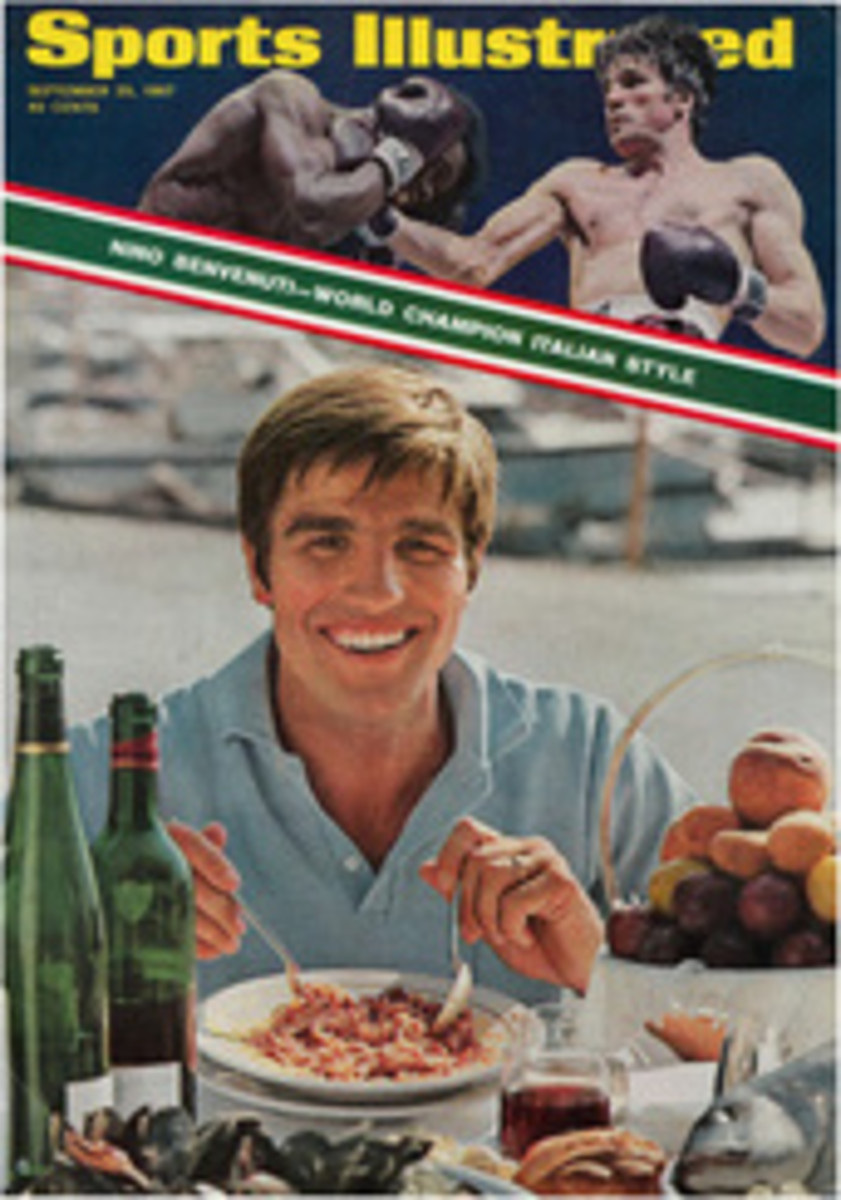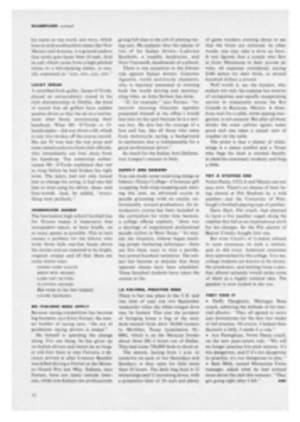
A break, a wrench and a march of new quarterbacks
An hour or so before the kickoff against the Denver Broncos last week, a tall, young, pleasant-looking elementary schoolteacher named John Stofa undressed in front of his cubicle in the Miami Dolphins' locker room at the Orange Bowl. Stofa hung his white shirt and gray-plaid suit on a hook a few feet from the street clothes of two much more highly paid and famous quarterbacks—Bob Griese and Rick Norton. After loosening up on the field during a warm and humid Miami afternoon, Stofa pulled on a pale-blue Dolphin jersey with No. 15 on it and ran out to lead his team while Griese and Norton went to the bench. It was the sort of thing that dreamers thrive on.
Four hours later the white shirt and gray-plaid suit were still hanging on the hook, but Stofa was not there to wear them. He was at Mercy Hospital, awaiting an operation on a broken ankle and a sprained knee. Stofa had lasted a bit less than five minutes against Denver. Griese, the rookie from Purdue, was now the new Miami quarterback, and Stofa's opportunity was gone, perhaps for the season, perhaps forever.
When he saw Stofa down and unmoving near the Miami goal line early in the first quarter, Griese was thinking of what he had to do. He did not watch as trainers taped Stofa's ankles together and brought out the stretcher. Griese is only 22 and is less than four months out of college, and this was Miami's first American Football League game of the year. In exhibition games he had thrown six passes and completed one while Dolphin Coach George Wilson was trying to decide which of his quarterbacks he would use on opening day.
"I was thinking what plays we would run," Griese said, describing how he reacted as Stofa was carried from the field. "I was thinking what was safe, what would work. As a quarterback, you have got to be ready. I wasn't apprehensive. I knew what my guys could do. It was their guys that bothered me."
That was a matter that was also puzzling to the Broncos. Denver is a rebuilt team with the stress on youth. Among the 22 offensive and defensive starters, five are rookies and eight are beginning their second season. The young Broncos held together very well during the exhibitions, beating both Detroit and Minnesota of the National Football League. But two weeks ago Denver was humbled 51-0 by Oakland.
Part of the blame for that swamping loss went to the absence of Cookie Gilchrist, who is out for most of the season with a knee injury. Gilchrist was Denver's policeman and as a pass-blocking fullback had few peers at picking up blitzing linebackers. Without Gilchrist to contend with, the Raiders poured in on Quarterback Steve Tensi and limited the Bronco passing to two completions for a total of minus yardage.
"We miss Cookie a lot," said Tensi as he prepared for the game with Miami. "With all our rookies, we need some old heads in there to keep us steady. A smart team can jump on our mistakes."
The Raiders leaped up and down on Denver mistakes like acrobats on a trampoline, but Bronco Coach and General Manager Lou Saban accepted the pummeling with outward tranquillity. He merely pointed out to the players which ones had been the worst offenders. Then he put the Broncos through a long work week and loaded them aboard a plane for the flight to Miami.
Tensi, who had played his college football in Florida, was eager for a good performance in the Orange Bowl. Like Stofa, he was getting his first chance at a regular big-league job. But while Stofa was playing in the minors, where the Dolphins found him, Tensi was spending two seasons behind John Hadl at San Diego. He was traded to Denver this year for two future first-round draft choices, which is a cheap price if Tensi makes it and a stiff one if he does not.
"Sid Gillman [San Diego Coach] called me in awhile back and told me he'd done me a favor, traded me to Denver," said Tensi, who is 6'5" and wears his hair in long sideburns like an electric-guitar player. "I said, Thanks, see you later.' I was very happy about it. There is a great difference in playing for Denver and playing for San Diego. In San Diego our ready book of plays to use in a game was the size of the Miami telephone book. In 60 minutes you couldn't use half of it. In Denver our ready book is about half the size of the Miami Yellow Pages. It's a much simpler offense. It's great for a quarterback. You hear it, you know it, it clicks. At San Diego we had meetings from 8 a.m. until midnight with practices in between. If I'd been paid by the hour at San Diego, I'd be a millionaire today."
Tensi has had a reputation as a fine quarterback since he was at Florida State. That is not true in the case of the unfortunate Stofa. He played college football at the University of Buffalo, where passes were seldom thrown. The drafts skipped him. Months later Bud Asher, coach of the Daytona Beach Thunder-birds in the Southern Professional Football League, was looking at movies of the 1962 Buffalo-Colgate game and was struck by one long pass completed for a touchdown in a blizzard. "I figured a boy who could lay in a pass like that would be a heller in the sunshine," Asher said, and signed Stofa to a contract.
Stofa played for the Thunderbirds in 1964 and 1965 at a salary of $100 per game and took them to two championships. In those two years Stofa, son of a steelworker in Johnstown, Pa., threw 75 touchdowns and the Thunderbirds won 29 of 31 games. He got a 10-day trial with the Dolphins in 1966, was cut and spent six weeks with the Pittsburgh Steelers. "We had five or six quarterbacks in camp," says Steeler Backfield Coach Don Heinrich. "They couldn't get all the work they needed. John was subdued and tended to be behind in recognizing defenses. He was nervous and had a bad game against Minnesota. It was a tough situation, but when you're going against five other guys there won't be a second chance. We cut him the next day."
Being released by Pittsburgh caused Stofa to doubt himself. "When you fail twice in two months, you can't help wondering about yourself," he said before the Denver game last week.
Stofa got a job teaching elementary school in Daytona Beach and joined the Lakeland Club in the North American Football League, commuting 110 miles to practice. Midway last season Miami's bonus-boy Quarterback Norton got a broken jaw and Stofa got a phone call from the Dolphins.
"I couldn't tell them right away that I'd come," said Stofa. "I had a teaching contract, and it wouldn't have been ethical to leave without a release. But the school board was nice about it. I knew I had to try once more."
George Wilson Jr., son of the Miami coach, was the Dolphin quarterback by then. Stofa sat on the bench for seven weeks. In the final 1966 game against Houston, Wilson Jr. was out, Dick Wood got a sore arm warming up and, with five minutes' notice, Stofa became the starting quarterback. He hit 22 of 38 passes for 307 yards and four touchdowns, and Miami won, 29-28. In that one game the Dolphins set team offensive records in nine categories, and Stofa established five individual records.
Last July Stofa went to training camp to discover he was being rated behind two rookies—Griese, and Jon Brittenum of Arkansas. "The money those other guys got for signing doesn't bother me," said Stofa, who was drawing a $15,000 salary. "If money had anything to do with it, I wouldn't be here. When I see Griese throw the ball well, it makes me try harder. There's always going to be pressure. The sooner I get used to it, the better off I'll be. I keep telling myself this is not only my big chance, it's my last chance. I'm 25 and too many good quarterbacks are coming up."
Although Stofa was not, in Wilson's opinion, Miami's best quarterback mechanically, the coach settled on him because of his leadership qualities. "He picks up the team," Wilson said. "The club plays for him, and that's what a quarterback is for. Leadership is born with a man, not put in by coaches."
Stofa was good enough in the exhibition games to cause Miami to trade Brittenum to San Diego. He walked into the Dolphin locker room at the Orange Bowl last Sunday in exactly the position he had always wanted—No. 1 quarter-back on a professional football team, with Griese and Norton, the college heroes, waiting behind him.
On the first offensive play for Miami, Halfback Joe Auer swung down the sideline and Stofa hit him with a 45-yard pass. Then he passed to End Howard Twilley for six more yards to the Denver eight. On the third play Stofa kept the ball and ran around right end for a touchdown. After less than two minutes Miami led by seven points and Stofa looked less like an elementary schoolteacher than he did a Johnny Unitas.
Denver punted, and Miami got the ball again on its own nine. First down. There was a fumble and a herd of players fought for the ball. All of them finally stood up except Stofa. He left the stadium in an ambulance.
In came Griese. He took the Dolphins on an 80-yard drive in the second quarter and threw a 27-yard touchdown pass to Sam Price for a 14-0 lead at the half. In the third quarter Griese called the same play Stofa had opened the game with and connected with Auer for a 68-yard touchdown. Then the Broncos, suddenly playing as well as they had in the preseason, moved into a 21-21 tie in the fourth quarter. But the Dolphins, with good passing from Griese and excellent running from Auer and Abner Haynes, won the game going away, 35-21.
"I need to know more about defenses," said Griese afterward, as an equipment man was packing away Stofa's helmet and pads from the cubicle where the gray-plaid suit hung. "I made a few bad calls that hurt us. I have to get experience. But I had some great backs to give the ball to." Auer and Haynes, who play the same position, complement each other perfectly. "And there's no jealousy," said Haynes, who tore away on a 65-yard touchdown run reminiscent of the years when he was the AFL's best. "I got way too much sense for that and so does Joe. We pull for each other."
Haynes had an incentive Sunday. He is one of 10 Dolphins who are ex-Denver Broncos. That may become 11. The latest could be George Wilson Jr., who was traded to Denver and then dropped. "Where else," says George Wilson Sr., "could I get a third quarterback without having to pay transportation expenses?" Facing a full season with a rookie quarterback, the Dolphins will wish Stofa's dream had lasted somewhat longer.
PHOTO
TWO DAYS BEFORE HIS ACCIDENT, A SOUND STOFA HURLED HARD PASSES IN PRACTICE

